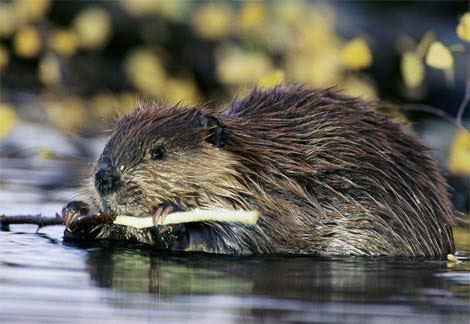 The history of the North American beaver (Castor Canadensis) as a national symbol of Canada is both fascinating and contentious. Explorers once scoured the wilderness across the country to acquire its rich and waterproof fur pelt, used to make top hats, which were all the rage in the 1600s and 1700s. Today, the beaver is immortalized on the Canadian nickel, the crest of the Canadian Pacific Railway Company and, perhaps most affectionately, the Canadian winter delicacy of sugary fried dough popularly known as “beavertail.”
The history of the North American beaver (Castor Canadensis) as a national symbol of Canada is both fascinating and contentious. Explorers once scoured the wilderness across the country to acquire its rich and waterproof fur pelt, used to make top hats, which were all the rage in the 1600s and 1700s. Today, the beaver is immortalized on the Canadian nickel, the crest of the Canadian Pacific Railway Company and, perhaps most affectionately, the Canadian winter delicacy of sugary fried dough popularly known as “beavertail.”
But these symbols only graze the surface of the deeper historical impact beavers have had as transformers of the Canadian landscape. Natural builders and industrious hydro-engineers, the beaver’s preferred craft is to manufacture small reservoirs throughout watersheds. Inside the flooded area, they build their own lodge out of mud, gravel and brush to protect themselves from predators.
Of course, not everyone enjoys sharing living space with beavers as they have been known to redecorate backyards, helping themselves to trees for building their lodges. This is part of the rationale that has lead The Methow Beaver Reintroduction Project in Eastern Washington to relocate “nuisance” beavers higher up in the watershed to habitat where they will thrive.
The project is part of a long-term plan to recover Spring Chinook Salmon and Steelhead Trout in the Columbia River — endangered fish species that flourish in cold-water stream habitats. When encouraged to store water higher up in the watershed, project proponents found that beavers naturally helped to create desirable aquatic habitat with lower water temperatures and restored stream complexity. With less water being stored in snowpack and glaciers, surface and groundwater storage created by beavers become essential water “savings accounts,” protecting biodiversity and increasing resilience to climate change.
For some First Nations cultures, the Totem Beaver symbolizes the value of hard work and teaches people to use their abilities productively, to be resourceful and persistent. The innate talents of the beaver to build have been conjured in storytelling to represent creativity, co-operation and the importance of teamwork.
So, the short answer to the question posed in the title of this article is yes! Beavers offer lessons on how to work effectively to address growing concerns of water quality, temperature and salmon recovery, all within the parameters of the natural habitat. Luckily for these popular rodents, the invention of silk top hats has kept the fur trade at bay, allowing the North American beaver to reestablish — and ecosystems to reap — the incredible benefits of their work habits.
 More interesting facts about beavers:
More interesting facts about beavers:
• Dietary preferences: Beavers are herbivores and enjoy eating leaves, twigs, bark and aquatic vegetation.
• Sensitive water-audio: Beavers are specially attuned to the sound of trickling water, so that they can quickly patch up leaks to a dam before water escapes.
• Buddy system: Sensing a threat, beavers use the pad of their tail to smack the surface of the water, warning other beavers before they themselves submerge into the water, where they can stay for up to 15 minutes.
• Big teeth: Beavers’ teeth never stop growing, which explains why they don’t wear down from chewing through trees! Their tooth enamel is also loaded with iron, making their super-strong teeth appear orange.
More information on The Methow Beaver Project can be found at ecotrust.org. This article was inspired by the PBS Nature feature “Leave it to Beavers.” You can find the episode on their website at pbs.org/wnet/nature.
Beneath The Surface is based on the principle that there is often more to know than what is visible from the “surface” of an issue. If there is something that concerns you about the lake and you want to get to the “bottom of it,” call Lake Windermere Ambassadors program co-ordinator Megan Peloso at 250-341-6898 or email info@lakeambassadors.ca and inspire the next column!
